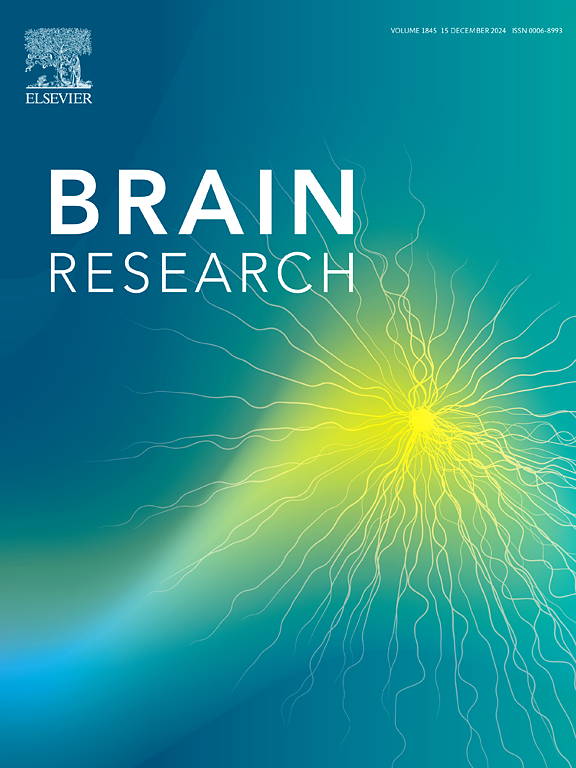与颜色诱发情绪相关的额叶α和顶叶θ不对称。
IF 2.7
4区 医学
Q3 NEUROSCIENCES
引用次数: 0
摘要
本研究通过主观评价研究了色彩感知--色调、亮度和饱和度--与情绪反应--愉悦、兴奋和愉悦之间的关系,并通过脑电图(EEG)记录研究了色彩感知与额叶和顶叶不对称活动模式之间的关联。我们使用伯克利色彩项目中的 37 种颜色以及正负对照图像,研究了 32 名墨西哥参与者(19 名女性;中位数 = 21.4 岁,标准差 = 3.3)对色彩的感知和情感维度。主观评价显示,情感与亮度、唤醒与饱和度之间存在很强的正相关性。明亮、唤醒和愉悦的颜色与左侧背外侧前额叶区域--即 F3 电极--更强的皮层激活(α 功率下降)有关,根据额叶α 不对称模型,这表明情绪处理是积极的。此外,右侧顶叶区(即 P4 电极)θ 功率的增加与较高的积极情绪和愉悦反应相关。我们的研究结果表明,感知颜色维度与情绪反应的关系具有普遍一致性。此外,主观情绪反应与非对称脑电活动模型之间的重要相关性也得到了强调,这为我们深入了解颜色诱发情绪感知的神经机制提供了线索,据我们所知,此前还没有其他研究做过这样的研究。进一步的研究应使用更高的空间分辨率成像技术和更大的电极阵列来探索这些关联,以精确界定所涉及的皮层和皮层下区域。这些结果有助于理解色彩感知对情绪的影响,并有可能应用于心理健康治疗,如治疗情绪障碍的色疗。本文章由计算机程序翻译,如有差异,请以英文原文为准。

Frontal alpha and parietal theta asymmetries associated with color-induced emotions
This study investigates the relationship between color perception—hue, brightness, and saturation—and its emotional response—valence, arousal, and pleasure—, through subjective evaluations, as well as their association with frontal and parietal asymmetric activity patterns through electroencephalographic (EEG) recording. Using the 37 colors from the Berkeley Color Project, along with positive and negative control images, we examined the perceptual and emotional dimensions of color in 32 Mexican participants (19 women; M = 21.4 years, SD = 3.3). Subjective evaluations revealed a strong positive correlation between valence and brightness, and between arousal and saturation. Brighter, arousing, and pleasant colors were associated with greater cortical activation (decreased alpha power) in the left dorsolateral prefrontal region—i.e., F3 electrode—, indicating positive emotional processing according to the frontal alpha asymmetry model. Additionally, increased theta power in the right lateral parietal region—i.e., P4 electrode—correlated with higher positive emotional and pleasurable responses. Our findings are in line with studies suggesting universal consistencies in how perceptual color dimensions relate to emotional responses. Moreover, significant correlations between subjective emotional responses and asymmetrical EEG activity models are highlighted, providing insights into the neural mechanisms of color-induced emotion perception, as no other study has done before to our knowledge. Further research should explore these associations using higher spatial resolution imaging techniques and larger electrode arrays to define precise cortical and subcortical regions involved. These results contribute to understanding color perception’s impact on emotions, with potential applications in mental health treatments, such as chromotherapy for mood disorders.
求助全文
通过发布文献求助,成功后即可免费获取论文全文。
去求助
来源期刊

Brain Research
医学-神经科学
CiteScore
5.90
自引率
3.40%
发文量
268
审稿时长
47 days
期刊介绍:
An international multidisciplinary journal devoted to fundamental research in the brain sciences.
Brain Research publishes papers reporting interdisciplinary investigations of nervous system structure and function that are of general interest to the international community of neuroscientists. As is evident from the journals name, its scope is broad, ranging from cellular and molecular studies through systems neuroscience, cognition and disease. Invited reviews are also published; suggestions for and inquiries about potential reviews are welcomed.
With the appearance of the final issue of the 2011 subscription, Vol. 67/1-2 (24 June 2011), Brain Research Reviews has ceased publication as a distinct journal separate from Brain Research. Review articles accepted for Brain Research are now published in that journal.
 求助内容:
求助内容: 应助结果提醒方式:
应助结果提醒方式:


